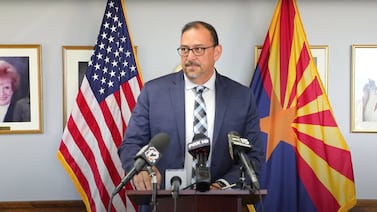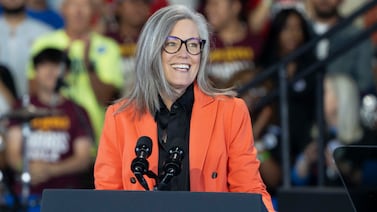It was an alarming claim that didn’t take long to go viral: Maricopa County had incorrectly rejected a ballot from an Arizona veteran in the November election, disenfranchising him.
Nearly a half million people saw the initial tweet by Abe Hamadeh, who narrowly lost his bid for attorney general last year and is still contesting the election. More than 1,000 people shared it. Hamadeh, a Republican, repeatedly referenced the veteran’s vote, saying that the situation was “exactly why I’m fighting.”
But there’s more to the story than the veteran’s own confusion, which appears to be genuine. He was not registered to vote in Maricopa County in 2022. In fact, he updated his voter registration to Navajo County in 2021, was given a receipt at the time showing as much, and was notified by Navajo County before the 2022 election that he was registered there, according to documents obtained by Votebeat.
In other words, the process appears to have worked as it should. But the veteran’s tale shows making sure you’re correctly registered to vote can still be confusing to voters, and stories such as his boost allegations of widespread voter disenfranchisement for which there is no evidence.
Votebeat is identifying the veteran only by his first name, Howard, because he didn’t respond to requests for an interview.
In this particular instance, the confusion may be from a recent change to how the state updates voters’ registration status.
To comply with federal law, under a 2020 settlement agreement, Arizona agreed to automatically prompt residents to update their voter registration when they update their address or driver’s license. If voters don’t want their registration updated, they have to actively opt out.
Hamadeh’s campaign argues the opt-out system isn’t transparent enough, and is disenfranchising voters like Howard. Proving that rejected ballots should have been counted is key for Hamadeh, as he attempts to convince a trial court to reconsider his election loss to Attorney General Kris Mayes. His case is pending in Mohave County.
There is no reliable data to back up Hamadeh’s claim. Arizona counties haven’t consistently tracked the number of registered Arizona voters who had their ballots rejected because they tried to vote in the wrong county, according to a Votebeat review of county data provided to the federal government.
What happened to the veteran’s vote?
Here’s what happened with the veteran Hamadeh featured, according to records provided to Votebeat from Maricopa County, Navajo County and the Motor Vehicle Department.
Howard registered to vote in Maricopa County in January 2017, according to the county’s records, and he voted in 2018 and 2020.
On Sept. 9, 2021, he went to a MVD office in Navajo County to get a new identification card. With help from an MVD employee, he filled out a form and listed his address in Show Low, in Navajo County. The “yes” box is checked on the question that asks if the person wants to register to vote or update their existing voter registration, and his signature is on the bottom, according to a copy of the form. His file also shows he was given a “voter registration application receipt” showing he was newly registered in Navajo County.
That process automatically sent a new voter registration form to Navajo County, triggering the county to add him to its voter rolls.
Maricopa County then received notice that he had been registered elsewhere in the state and canceled his registration on Sept. 10, 2021, according to the county’s records. State law requires this, stating that if a county recorder receives credible information that a person has registered to vote in a different county, they must confirm the registration with the other county and then cancel the previous registration.
In May 2022, before the primary election, Howard received notice from Navajo County that he was registered to vote at his Show Low address. This 90-day notice is required under state law, to help remind residents to update their registration, if needed, prior to an election. Howard responded, telling Navajo County to cancel his voter registration. He checked a box saying that he had moved away from Navajo County, according to the county’s records. But he didn’t reregister in Maricopa, records show.
With the 2022 primary election approaching, that meant he wasn’t registered to vote in either county.
Could there be unintended consequences to 2020 settlement?
One of Hamadeh’s lawyers, Jen Wright, who was assistant attorney general under former Attorney General Mark Brnovich, argues that the system isn’t transparent enough.
Service Arizona, the state’s electronic system for updating a license, ID or home address, auto-checks the box that asks if the voter wants to update their voter registration in order to comply with federal law. A voter who does not want to do that must uncheck the box.
The system has worked this way since 2020, when the state settled a case with the League of Women Voters and other voting rights groups.
The National Voter Registration Act requires states to use their driver’s license and change of address process to simultaneously update voter registration. All changes must be forwarded to election authorities “unless the registrant affirmatively requests otherwise by opting out on the form,” according to federal law. The groups had sued former Secretary of State Michele Reagan in 2018, claiming that the state was failing to provide this voter registration update option when voters updated their addresses. Reagan’s staff testified that as many as 384,000 residents had changed their MVD address without simultaneously updating their voter registration address in the two years prior to the lawsuit.
Voting rights groups considered the settlement a win. But Wright argues the system put in place as a result has caused widespread voter confusion, an assertion she said she is still gathering evidence to support. She believes that there should be on-screen warnings and prompts for users so that it’s more clear that their voter registration is being updated.
State officials believe there are plenty of warnings. After that initial checkbox, the next page on Service Arizona asks for more voter registration details.
“The question is repeated in bold at the top of the pop-up, and two additional voter registration questions are required, so it is always clear that you are registering to vote,” said Bill Lamoreaux, a spokesperson for the Arizona Department of Transportation.
If the person makes this change in person, they are given a printed receipt showing the changes, Lamoreaux said.
In terms of potential improvements, Howard, the veteran in the video featured by Hamadeh, might have found it helpful to receive a notice from Maricopa County when they canceled his voter registration.
State law only requires counties to notify voters when they are canceling their registration in specific circumstances where the voter did not initiate the change, such as when voters are taken off the rolls because the state has received notice that they died or were convicted of a felony.
“This was a voter-initiated request to be added to the Navajo County rolls and therefore removed from the Maricopa County voter rolls,” said Sierra Ciaramella, a spokesperson for the Recorder’s Office. “We assume the voter’s move was intentional and had no reason to believe otherwise.”
The county encourages voters to use their online system, beballotready.vote, to check their voter registration status, especially before an election. In other parts of the state, voters can use my.arizona.vote.
Meanwhile, Hamadeh’s campaign plans to use affidavits from voters similar to Howard to try to prove to the court that the voters had been disenfranchised.
Wright asserts Hamadeh’s campaign has a list of hundreds of potential cases in Maricopa County alone.
Clarification: This story was updated to more accurately reflect the testimony of former Secretary of State Michele Reagan’s staff in 2018.
Jen Fifield is a reporter for Votebeat based in Arizona. Contact Jen at jfifield@votebeat.org.






